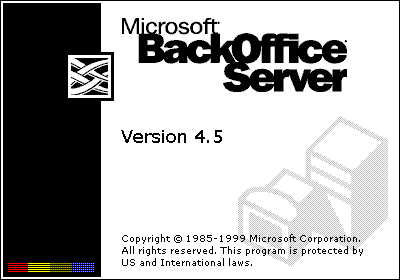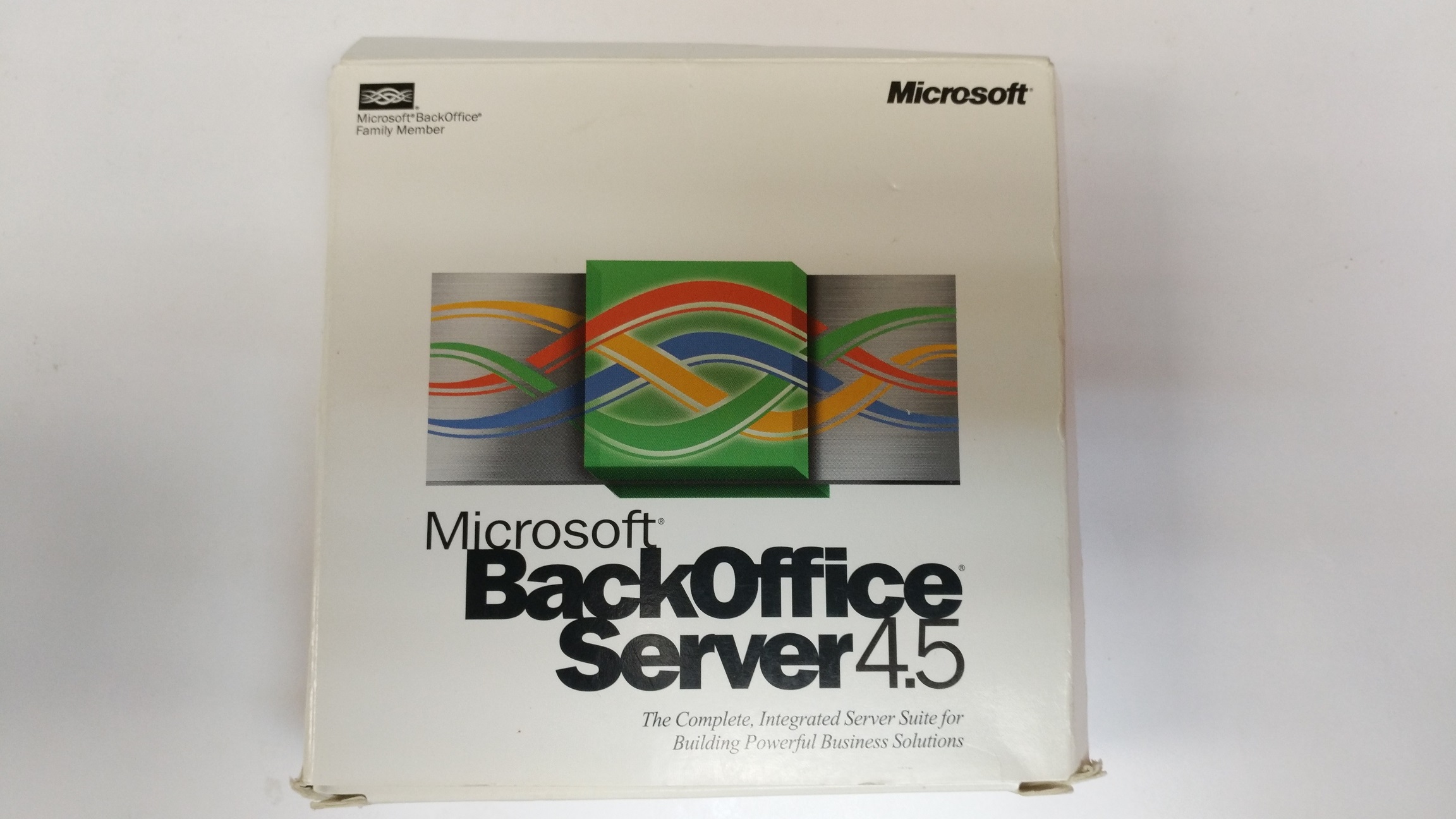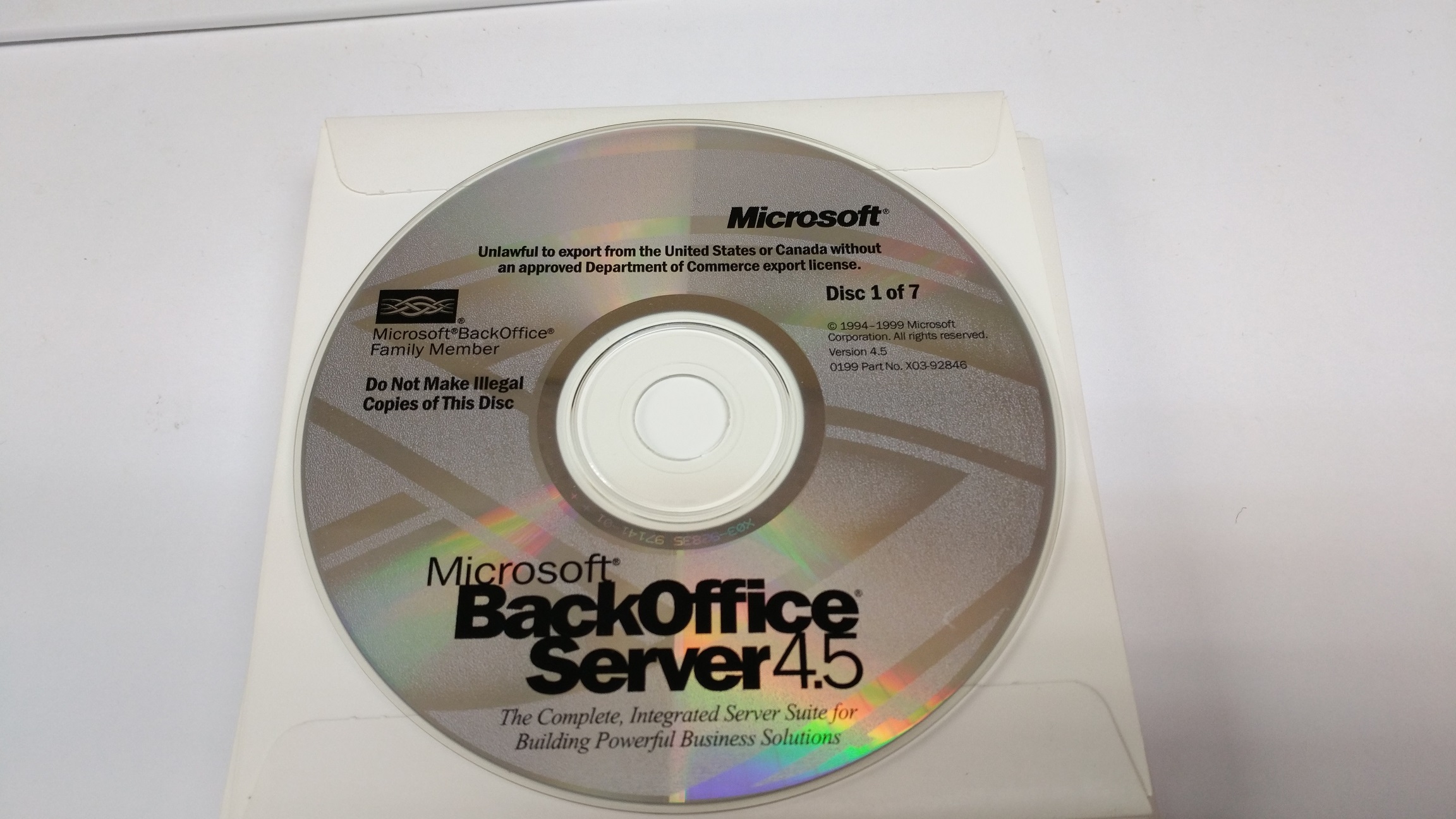
Stylized logo!
Every so often, I’ll get either emails or messages from various people wanting to run their own exchange server setup in a similar method that I have setup, except that they are lacking either Windows NT Server discs, or even the Exchange server disc. Â I always end up pointing people to eBay, although contrary to the last few years, prices of old Exchange Server have gotten expensive. Â However there is a different SKU, and way to get them both, plus a lot more, enter the late 1990’s server craze of product consolidation, Microsoft Back office.

Back Office media kit
In all version 4.5 comes on 7 CD’s containing:
- Windows NT Server 4.0/IE 5.0/MMC 1.0
- SQL Server 7.0
- Proxy Server 2.0/Option Pack
- Exchange Server 5.5
- Site Server 1.0
- Systems Management Server 2.0
- SNA Server 4.0
Before server virtualization took off, the trend for small branch offices and small organizations was to get a single server and try to run everything all at once. Â Of course this leads to an incredible amount of inter-tangled dependencies, and possible collisions when involving 3rd party software, along with possible performance issues for stacking so much onto one box. Â How times have changed! Â Where today we may run all the same services on a single physical box, however with each server component getting its own VM, it lends to far better stability as you don’t have so many applications with possible DLL/system versioning issues, and better resource management as you can easily prioritize VM’s or even suspended ones that are infrequently needed. Â Having lived through it, there was nothing like having a needed service pack for one issue on one component, which then broke something else. Â Needless to say this is why we have virtualization, and things like docker to deal with DLL hell.

CD’s
There is no real difference between these Back office versions of the server apps, which is why I would recommend this over a standalone package as you get so much more.
SMTP along with POP and IMAP, are largely unchanged. Â While Outlook 2016 may not support Exchange 5.5 directly, you can configure it as an IMAP server, and connect just fine. Â I’d highly recommend something like stunnel to wrap it with modern encryption, something that Windows NT 4.0 is lacking. Â Combined with an external relay to do “modern” features like DKIM, spam filtering and obscuring your server’s direct connection on the internet, there is nothing wrong with using it as a backed, even in 2017.
SQL 7 is the first version in the “rewrite” of Sybase SQL, supporting the new client libraries, which .Net 4.5 on Windows 10 can still happily connect to, unlike SQL 6.5 and below. Â I use it occasionally to quickly prototype stuff as needed or load up datasets to transform them. Â I also like the SQL scheduler to do jobs in steps, as it can catch error codes, and you can setup elaborate processes.
I can’t imagine having a use for SNA Server anymore as IBM had shifted all their mainframes from SNA, to TCP/IP. Â I would imagine with a current software contract that is what people would be using, but somehow I’d like to imagine some large organization still using 3270’s on people’s desks, and a SNA gateway to bring sessions to people’s desks. Â But that is highly unlikely. Â Back in the day COM/TI was a big deal to take COBOL transactions and package them up as Microsoft COM objects to later be called either directly, or middleware via DCOM. Â Although who knows, when it comes to legacy stuff, Im sure somewhere has type 1 token ring MAU’s, and SDLC links.
Packages like Back Office is what basically pushed out Novel from the market as they didn’t develop their own solutions in time, and deploying server software to Novel Netware proved to not only be very precarious, but along with it’s single application process space, proved to be extremely unreliable. Â Not to mention that older protocol companies like DEC, IBM or Novel were entrenched in their own proprietary network stacks, and TCP/IP was frequently seen as something to be purchased separately both for the OS, and the application. Â Microsoft certainly did the right thing by having a free TCP/IP for Windows for Workgroups, and including it in Windows NT, and Windows 95.
As always the option Pack for Windows NT 4.0 nearly brings it up to the functional level of Windows 2000, and is a great way to build that virtual corporation for testing.

So people do mail you about that? 😀
I just got BackOffice Server 4.0 following your hint. 4.5 wasn’t available on our eBay. I just checked the US eBay… now I’m wondering, is the Developer Edition of 4.5 worth getting?
I guess for my purposes all of these are fine.
Cheers,
Florian
Lol you may have been the tipping point, but it’s been 3 email threads about this exact same thing this month!!! So obviously it’s a thing, lol
I’ll have to see what the differences are between 4.5 and 4.0. the only other version I have is a trial of 1.5
Well, 4.5 includes bumped versions of everything, like NT4 SP4 instead of SP3, SQL Server 7.0 instead of 6.5, etc…
The interesting question is, what’s different in the developer edition.
I think the developer version is capped at 10 connections, like Workstation. Which for a single user Exchange setup is fine.
SQL 6.5 vs 7.0 is a big deal though. Same with Exchange 5.0 vs 5.5 …
But 5.0 had the IRC server!
I did forget about the whole IRC push from Microsoft, including the mal aligned (but personal favourite) Comic Chat!
Help me guys, what’s 5.0? After a quick search, I only found some book on Amazon. Is it the internal version of BackOffice 2000?
Exchange Server, it was a messaging add-on.
Exchange 5.0 – my bad.
Thanks. That’s a compelling argument for BackOffice 4.0 then. Somehow the idea of messing with a Microsoft IRC server intrigues me.
I think they kept it in until Exchange 2000…. Now I feel the need to install them all….
So do I. ?
Time to build that virtual company you were talking about. Do you know if Exchange-IRC supports linking servers?
I have a few bogus domains… like vaxenrule.com or teamos2.com …. and I have that hecnet bridge running on NT 4.0 that can do things like tcpip or netbeui …. we can build a virtual network… lol
Per the admin. console, it seems yes. You can link servers.
Let’s see…
* Hobbyist CHAOS network
* Hobbyist DECnet network
* Hobbyist USENET/uucp network
and now a hobbyist NT 4 network? I’m running out of ports! 😉
We can do an AppleTalk one too! … It should be trivial to re-do BasiliskII as a UDP client/server along with Shoebill…
Great Idea! How about we use VDE for networking? With VDE you get virtual Ethernet switches that can be connected using SSH. Or if switching is not your thing, you could connect a cisco router via dynamips to it.It’s really flexible. Emulators that don’t support it natively (SIMH, VirtualBox for example do) can be easily connected using tap interfaces.
The only reason I’d suggest the bridge is that my NT version has compression, and it’s upd, not too hard to open up. Dynamips is fun too, although it’s internal queuing is a bit throttled by design.
I think the infastructure part can run on its own, or I just really need to tear it apart
My edge router is a 7301…I’m good on any front 😉
I also natively use VDE already…except my NT VM is in VMware so I’d need to get creative 😉
I’ve been ignoring VDE as it’s a Linux only thing aka not for Windows. And I’m just sitting here with my 7206 NPE-G1 wishing it was a G2.
I’m open to pretty much anything. I guess what should we load up? We can connect like all the protocols. IPX, DECnet, tcpip, netbeui…. I should rig a curses Qemu MS-DOS thing…..
RRAS domain repl over VPN? 😉
My traditional VPN stuff gets throttled… Which is why I’m always looking for non standard ways of doing shit.
Grab an ATA and do 9600 baud over my PBX? 😉
I have a POTS line in Hong Kong, I’m not ready for the LD charges!!
http://vpsland.superglobalmegacorp.com/install/WindowsNT4.0-i386/rras/
Turns out I actually have the rras package!
SIP ATA! That way it’s all internal to the PBX so costs me like $0.00002 in power. 😀
Didn’t think it’d carry a modem.. I guess I need a 7300
Although I’ve been wanting to get a 7000 or AGS
Hobbyist Appletalk? Done! http://www.synack.net/~bbraun/avpn.html
Although its not a “traditional” Appletalk network, just a tunnel to a netatalk server over TCP/IP. There are Appletalk tunneling (over TCP/IP) protocols out there that can connect two networks, but they weren’t widely supported outside of the Shiva Fastpath 5 or the Cayman Gatorbox routers.
the site is down… Although what I was thinking was a bridge, so you would run this on a windows or unix/os x machine on your network, and it then picks up the apple talk packets and sends them to other bridges. that way you only need one machine to do the bridging, and the othermachines just need ethenet…
I’m finally getting some traction using VDE as interconnects+dynamips running Cisco IOS…
Old crap net is slowly happening…
OK Im a slacker, let me put something together….. maybe this is the time to mess with VDE…
I have actually used SNA Server in a hobby network. Granted, all I did was hook it up to one of my AS/400s and use 5250 terminal emulation.
Well that is kind of cool! .. How do you connect? on a LAN with DLC? SDLC cards?
I really should have ran a packet capture when I used to have access to a mainframe to get the LU going active, and a terminal session going live, along with input & output….. Don’t know why I never did.
fwiw, the IRCd was in Exchange 5.5. 2000 (at least the one in SBS 2000) replaces it with an MSNP IM server, using MSN Messenger.
Sounds cool though!
Ex-friend sent me the Back Office 4.5 MSDN CDs nearly 15 years ago. Didn’t have the hardware resources to run it back then, since I was limited to a 1999 IBM Aptiva and I wasn’t going to mess with it.
About 5 to 7 years ago, I had installed it in Virtual PC, had Exchange setup and was able to manage a Windows NT 3.1 and 4.0 Workstations from it. Even had Outlook 97 working and Web Access. I must say, it was really easy to use. Got bored eventually. Probably should give it a try again. I also have Small Business Server 2000 and 2003, but never played with them. 15 years ago, when I dreamed of having access to all this software and what I would do, now I do and I don’t care.
I should check my MSDN sub to see if they still host the defunct Mid Market Server 2008 and another variant.
It’s always the way, isnt it?
Microsoft has killed Exchange in the newer small business servers as they are steering everyone towards the hosted office 365 stuff.
I just think it’s neat in the age of fast machines, emulating things like routers, switches, and servers make it possible to build up an entire intranet on a single machine.